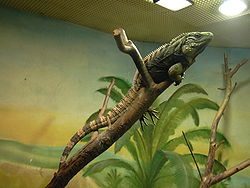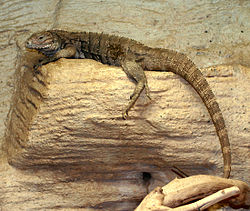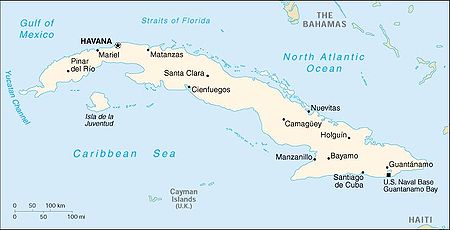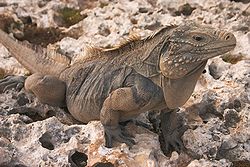- Cyclura nubila
-
Cuban rock iguana 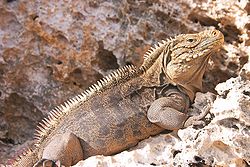
Conservation status Scientific classification Kingdom: Animalia Phylum: Chordata Class: Sauropsida Order: Squamata Family: Iguanidae Genus: Cyclura Species: C. nubila Binomial name Cyclura nubila[2]
(Gray, 1831)Subspecies - Cyclura nubila caymanensis
- Cyclura nubila nubila
Cyclura nubila, also known as the Cuban rock iguana, Cuban ground iguana, or Cuban iguana,[3] is a species of lizard of the iguana family. It is the largest of the West Indian rock iguanas (genus Cyclura), one of the most endangered groups of lizards. This herbivorous species with red eyes, a thick tail, and spiked jowls is one of the largest lizards in the Caribbean.
The Cuban iguana is distributed throughout the rocky southern coastal areas of mainland Cuba and its surrounding islets with a feral population thriving on Isla Magueyes, Puerto Rico. It is also found on the Cayman Islands of Little Cayman and Cayman Brac, where a separate subspecies occurs. Females guard their nest sites and often nest in sites excavated by Cuban crocodiles. As a defense measure, the Cuban iguana often makes its home within or near prickly-pear cacti.
Although the wild population is in decline because of predation by feral animals and habitat loss caused by human agricultural development, the numbers of iguanas have been bolstered as a result of captive-breeding and other conservation programs. Cyclura nubila has been used to study evolution and animal communication, and its captive-breeding program has been a model for other endangered lizards in the Caribbean.
Contents
Taxonomy
The Cuban rock iguana's generic name Cyclura is derived from the Ancient Greek cyclos (κύκλος) meaning "circular" and ourá (οὐρά) meaning "tail", after the thick-ringed tail characteristic of all Cyclura.[4][5] John Edward Gray, the British zoologist who first described the species in 1831 as Iguana (Cyclura) nubila or "Clouded Guana", gave it the specific name nubila, Latin for "cloudy".[3][6][7]
The closest relatives of Cyclura nubila are the Grand Cayman blue iguana (Cyclura lewisi) and the Northern Bahamian rock iguana (Cyclura cychlura); phylogenetic analysis indicates that these three species diverged from a common ancestor three million years ago.[8]
Cyclura nubila was previously considered to have three subspecies, the Grand Cayman blue iguana (termed Cyclura nubila lewisi), the Lesser Caymans iguana (Cyclura nubila caymanensis), and the nominate Cuban subspecies (Cyclura nubila nubila).[3][9] This classification was revised after later mitochondrial DNA analysis and research into the scalation patterns on the heads of Caribbean iguanid lizards (these patterns are unique by species and act as a "fingerprint" of sorts).[3][10][11] The Grand Cayman blue iguana is now recognized as a separate species.[3][10][11][12][13][14]a
Anatomy and morphology
The Cuban iguana is a large lizard, with an average body length of 40 centimeters (16 in) from snout to vent (the base of the tail).[3] On rare occasions, individual males with lengths of 1.6 meters (5.2 ft) when measured from the snout to the tip of the tail have been recorded at the wildlife sanctuary within the Guantanamo Bay Naval Base (GTMO), Cuba with females being two thirds that size.[15][16] The species is sexually dimorphic: males are much larger than females, and males have enlarged femoral pores on their thighs, which are used to release pheromones to attract mates and mark territory.[17][18][19] The skin of male Cuban iguanas ranges in color from dark gray to brick red, whereas that of females is olive green with dark stripes or bands.[17] In both sexes, limbs are black with pale brown oval spots and solid black feet.[17] Young animals tend to be dark brown or green with faint darker striping or mottling in five to ten diagonal transverse bands on the body.[17] These bands blend in with the body color as the iguana ages.[17] Both sexes possess a dewlap (skin hanging below the neck) and a row of spines running down their back to their thick tail.[17] Their heads and necks are short and stout, their teeth are solid and broad, and they have powerful jaw muscles.[20] Their jowls, which grow larger as the animal ages, are covered in spiky protuberances called tubercles.[20]
The Cuban iguana's eyes have a golden iris and red sclera. Cuban iguanas have excellent vision and the ability to detect shapes and movement at long distances.[21] Sensory cells called "double cones" give them sharp color vision and enable them to see ultraviolet wavelengths.[21] By seeking out locations with more ultraviolet sunlight to bask in, the Cuban iguana optimizes vitamin D production.[22] Cuban iguanas have poor low-light vision, because they have few rods or photoreceptor cells. Like other iguanids, Cuban iguanas have a white photosensory organ on the top of their heads, called the parietal eye.[21] This "eye" has only a rudimentary retina and lens and cannot form images, but it is sensitive to changes in light and can detect movement.[21]
Diet
Like all Cyclura species, the Cuban iguana is primarily herbivorous; 95% of its diet consists of the leaves, flowers and fruits from as many as 30 plant species, including the seaside rock shrub (Rachicallis americana), thistle, prickly pear (Opuntia stricta), black mangrove (Avicennia germinans), red mangrove (Rhizophora mangle), olives, and various grasses.[23] Aiding in the digestion of this high-cellulose diet, colonies of nematodes occupy 50% of the contents of Cuban iguanas' large intestines.[17][23] Cuban iguanas occasionally consume animal matter, and individuals have been observed scavenging the corpses of birds, fish and crabs.[24][25] Researchers on Isla Magueyes observed a single episode of cannibalism in 2006 when an adult female iguana chased, caught, and ate a hatchling. The researchers wrote that the dense population on Isla Magueyes could have caused this incident.[26]
Like other herbivorous lizards, the Cuban iguana is presented with a problem for osmoregulation: plant matter contains more potassium and has less nutritional content per gram than meat so more must be eaten to meet the lizard's metabolic needs. Unlike those of mammals, reptile kidneys cannot concentrate urine to save on water intake. Instead, reptiles excrete toxic nitrogenous wastes as solid uric acid through their cloaca. In the case of the Cuban iguana, which consumes large amounts of vegetation, these excess salt ions are excreted through the salt gland in the same manner as in birds.[27]
Mating and behavior
Cuban iguanas reach sexual maturity at an age of two to three years.[1] Males are gregarious when immature, but become more aggressive as they age, vigorously defending territories in competition for females.[23] Females are more tolerant of each other, except after laying their eggs.[17][23]
Mating occurs in May and June, and females lay single clutches of three to 30 eggs in June or July.[1][17][23] According to field research, females deposit their eggs at the same nesting sites each year.[23] The nests are built near each other as suitable nesting sites are becoming rare.[17][23] On Cuba's Isla de Juventud, Cuban iguanas nest in pockets of earth exposed to the sun by Cuban crocodiles, after the crocodiles' eggs have hatched.[1][17][23] These nests are separate from where adult iguanas live.[1][17][23] In areas without crocodiles, the iguanas excavate nests in sandy beaches.[17] At the San Diego Zoo, a female built a nest at the end of a long chamber she excavated in the sand.[17] She stood near it for weeks, defending it by shaking her head and hissing at anyone who approached; this behavior demonstrated that Cuban iguanas guard their nest sites.[17] The hatchlings spend several days to two weeks in the nest chamber from the time they hatch to the time they emerge from the nests; dispersing individually after emergence.[28]
Although Cuban iguanas typically remain still for long periods of time and have a slow lumbering gait due to their body mass, they are capable of quick bursts of speed for short distances. Younger animals are more arboreal and will seek refuge in trees, which they can climb with great agility. The animal is a capable swimmer and will take to nearby water if threatened. When cornered they can bite and lash their tails in defense.[29]
Distribution and habitat
The Cuban iguana is naturally distributed in rocky coastal areas on Cuba and throughout as many as 4,000 islets surrounding the Cuban mainland, including Isla de la Juventud off the southern coast, which has one of the most robust populations.[3][17][24] Relatively safe populations are found on some islets along the north and south coasts and in isolated protected areas on the mainland.[1] These include Guanahacabibes Biosphere Reserve in the west, Desembarco del Granma National Park, Hatibonico Wildlife Refuge, Punta Negra-Quemados Ecological Reserve, and Delta del Cauto Wildlife Refuge, all in eastern Cuba.[24] Because of this wide distribution, accurate information about the number of distinct subpopulations of Cuban iguanas cannot be determined.[3][24] The population on the US Naval Base at Guantánamo Bay has been estimated at 2,000 to 3,000 individuals, and the animals are treated well and protected by US forces stationed at the base.[1][15][16] An unusual incident occurred when a detainee in the prison assaulted a guard with a bloody tail torn from a Cuban iguana in May 2005.[30][31]
The subspecies, Cyclura nubila caymanensis, is endemic to the "Sister Islands" of Little Cayman and Cayman Brac. The population on Cayman Brac is less than 50 of these animals and Little Cayman supports 1,500. A feral population of C. n. caymanensis has been established on Grand Cayman.[13]
The Cuban iguana makes its burrow near cacti or thistles, sometimes even within the cactus itself.[23] These thorny plants offer protection and their fruit and flowers offer the iguanas food.[17][23][32] In areas without cacti, the lizards make their burrows in dead trees, hollow logs, and limestone crevices.[17][32]
In the mid-1960s a small group of Cuban iguanas was released from a zoo on Isla Magueyes, southwest of Puerto Rico, forming an independent free-ranging feral population.[28][33] As of 2000, there has been talk of removing or relocating this population of iguanas by the US Department of Interior. This feral population is the source for 90% of the captive Cuban iguanas held in private collections and was the source for part of a study on animal communication and evolution conducted by Emilia Martins, a biologist at Indiana University.[34]
Martins' study compared the head-bob displays from the source population on Cuba with these animals on Isla Magueyes.[34] The durations and pauses were longer by as much as 350% in the feral population.[34] In comparison, the blue iguana of Grand Cayman's head-bob displays differed from those of the animals on Cuba by only about 20%.[34] The rapid change in display structure between the colony of animals on Isla Magueyes and those on Cuba illustrated the potential of small founding population size as a catalyst to evolution with regard to communication or display.[34] In this case the difference was by only six generations at most.[34]
Conservation
The Cuban iguana is well-established in public and private collections.[22] Many zoological parks and private individuals keep them in captive breeding programs, minimizing the demand for wild-caught specimens for the pet trade.[22] Cuban iguanas are listed as "vulnerable" on the IUCN Red List.[1] The total population in Cuba is estimated at between 40,000 and 60,000 individuals, and the feral population on Isla Magueyes is estimated at over 1,000.[1] According to Allison Alberts, Chief Conservation Officer of the San Diego Zoo and lead researcher in Cuba, among the many wildlife species at GTMO, "The Cuban Iguana is one of the largest, undoubtedly the most visible, and certainly the most charismatic. It seems that no one completes a tour of duty at GTMO without getting to know these prehistoric-looking giants."[16]
In a round-about way, the Cuban iguana's status under the US Endangered Species Act made its way into US jurisprudence. In the fall of 2003, attorney Tom Wilner needed to persuade the justices of the US Supreme Court to take the case of a dozen Kuwaiti detainees being held in isolation in Guantanamo Bay, Cuba, without charges, without a hearing and without access to a lawyer.[35] According to Peter Honigsberg, a professor of law at the University of San Francisco, Wilner unsuccessfully made two arguments before the Court to hear his case; in his third argument he changed tactics by mentioning US law and the Cuban iguana.[35][36] Wilner argued, "Anyone, including a federal official, who violates the Endangered Species Act by harming an iguana at Guantanamo, can be fined and prosecuted. Yet the government argues that US law does not apply to protect the human prisoners there".[37] According to Honigsberg, the Supreme Court agreed to hear the case because of this argument.[35]
Decline
In general the species is in decline, more quickly on the mainland than on the outlying islets.[1] The Cuban mainland populations have been declining at a rate of over 1% per year for the last 10 years.[1] The Cuban iguana is no longer found on the northeastern coast of Havana, the Hicacos Peninsula, or Cayo Largo, areas where it was found in great numbers some 30 to 40 years ago.[1]
As opposed to other West Indian islands where iguanids are found, consumption of iguana meat is not widespread in Cuba.[38] Certain fishing communities do practice it for subsistence, but for the most part the animal is not eaten by Cubans.[38] According to naturalist Thomas Barbour, this is based on unfounded superstitious beliefs which suggest that the iguanas emit a dark fluid reminiscent of the black vomit of yellow fever victims when they are killed.[38][39] One of the reasons for their decline is habitat destruction caused by the overgrazing of farm animals, housing development, and the building of tourist resorts on the beaches where the animals prefer to build their nests.[1][10] Populations of iguanas suffer by the direct predation of introduced animals such as rats, cats, and dogs.[1] Feral hogs are responsible for destroying many iguana nest sites which they dig up for eggs.[1] Ant predation of iguana eggs is another threat to the species.[28]
Recovery
All but one of the major iguana concentrations are either partially or fully protected by the Cuban government.[17] Although no captive-breeding program exists within Cuba, the Centro Nacional de Areas Protegidas (the National Center for Protected Areas) has suggested it will explore this route in the future.[17] In 1985 the Cuban government issued a commemorative peso depicting a Cuban iguana on the head side of the coin in an attempt to raise awareness for this animal.[17]
In 1993 the San Diego Zoo experimentally tested the utility of a "head-starting" program for newly hatched Cuban iguanas with funding from the National Science Foundation's Conservation and Restoration Biology Program.[16][40] "Head-starting" is a process by which the Cuban iguana's eggs are hatched in an incubator and the animals are protected and fed for the first 20 months of their lives.[16][40] The purpose is to get the animals to a size where they are more capable of fleeing from or fighting off predators.[16][40] This technique was originally used to protect hatchling sea turtles, Galapagos land iguanas, and Ctenosaura bakeri on the island of Utila, but Alberts used it for the first time on a Cyclura species with the Cuban iguana.[40] The purpose was not only to help the Cuban iguana population, but to test the overall effectiveness of headstarting as a conservation strategy for more critically endangered species of Cyclura.[40]
The strategy proved successful, according to Alberts, when the released head-started iguanas reacted to predators, foraged for food, and behaved like their wild-born counterparts.[40][41] This strategy has been implemented with great success with other critically endangered species of Cyclura and Ctenosaura throughout the West Indies and Central America, notably the Jamaican iguana, Grand Cayman blue iguana, Ricord's iguana, Allen Cays iguana, San Salvador iguana, and Anegada iguana.[16][40]
References
- ^ a b c d e f g h i j k l m n o "Cyclura nubila". IUCN Red List of Threatened Species. Version 2007. International Union for Conservation of Nature. 1996. http://www.iucnredlist.org/apps/redlist/details/6045. Retrieved August 25, 2007.
- ^ "Cyclura nubila". Integrated Taxonomic Information System. http://www.itis.gov/servlet/SingleRpt/SingleRpt?search_topic=TSN&search_value=173919. Retrieved December 4, 2009.
- ^ a b c d e f g h Hollingsworth, Bradford D. (2004). The Evolution of Iguanas: an Overview and a Checklist of Species. Berkeley, CA: University of California Press. p. 37. ISBN 978-0-520-23854-1.
- ^ Roberts, George; Mark D. Zalesky (2009). An Etymological and Explanatory Dictionary of the Terms and Language of Geology. BiblioLife. p. 80. ISBN 978-1-103-11533-4.
- ^ Sanchez, Alejandro. "Family Iguanidae: Iguanas and Their Kin". Father Sanchez's Web Site of West Indian Natural History Diapsids I: Introduction; Lizards. Kingsnake.com. http://www.kingsnake.com/westindian/metazoa10.html. Retrieved November 26, 2007.
- ^ Cuvier, G.; Pidgeon, E.; Gray, J.E. (1831). The class Reptilia, with specific descriptions by E. Griffith and E. Pidgeon.. The Animal Kingdom Arranged in Conformity with Its Organization, Vol. 9 (Griffith, E., ed.). Printed for G. B. Whittaker. p. 39. http://books.google.com/?id=_n1IAAAAMAAJ&dq=Cyclura%20nubila%20Gray%201831&pg=PT40#v=onepage&q=.
- ^ Pinkster, Harm (main editor) (2003). Woordenboek Latijn/Nederlands. (2nd revised ed.). Amsterdam: Amsterdam University Press. p. 693. ISBN 90-5356-607-4.
- ^ Kenyon, Georgina (September 17, 2005). "Pulling the blue iguana from the brink". New Scientist (Simone Coless) (2517): 42–43. http://www.newscientist.com/channel/life/mg18725172.400. Retrieved 2009-12-07.
- ^ Schwartz, A.; Carey, M. (1977). "Systematics and evolution in the West Indian iguanid genus Cyclura". Studies on the Fauna of Curaçao and Other Caribbean Islands 53 (173): 15–97.
- ^ a b c Malone, Catherine; Davis, Scott (2004). Genetic Contributions to Caribbean Iguana Conservation. Berkeley, CA: University of California Press. pp. 45–57. ISBN 978-0-520-23854-1.
- ^ a b Malone, Catherine L. (2000). Phylogenetics, biogeography, and conservation of Caribbean iguanas (Cyclura and Iguana) (PhD thesis). Texas A&M University.
- ^ Malone, Catherine L.; Wheeler T.C., Davis S.K., and Taylor J.F. (2000). "Phylogeography of the Caribbean rock iguana (Cyclura): implications for conservation and insights on the biogeographic history of the West Indies". Molecular Phylogenetics and Evolution 17 (2): 269–279. doi:10.1006/mpev.2000.0836. PMID 11083940.
- ^ a b Burton, Frederick (2004) (PDF). Taxonomic Status of the Grand Cayman Blue Iguana. 8. Caribbean Journal of Science. pp. 198–203. http://www.caribjsci.org/aug04/40_198-203.pdf. Retrieved 2007-09-16.
- ^ Burton, Frederick (2004). Revision to species of Cyclura nubila lewisi, the Grand Cayman Blue Iguana. 40. Caribbean Journal of Science. pp. 198–203.
- ^ a b Frantom, Todd (2005). "Cuban Sanctuary". All Hands (Navy News Service) 87 (1058): 14. http://www.navy.mil/media/allhands/acrobat/ah200506.pdf. Retrieved December 4, 2009.
- ^ a b c d e f g Nelson, Robert (1 August 2001). "A Safe Haven For Wildlife: Naval Base Guantanamo Bay Provides Sanctuary For Iguana" (PDF). Currents: Navy Environmental News. http://www.enviro-navair.navy.mil/currents/fall2001/Currents%20Fall%202001-web.pdf. Retrieved August 23, 2007.
- ^ a b c d e f g h i j k l m n o p q r s t u Schettino, Lourdes Rodriguez (1999). The Iguanid Lizards of Cuba. Gainesville, Florida: University Press of Florida. p. 428. ISBN 978-0-8130-1647-4.
- ^ Winker, Carol (February 8, 2007). "Iguanas get royal attention". Caymanian Compass. http://www.caycompass.com/cgi-bin/CFPnews.cgi?ID=1019861. Retrieved December 4, 2009.
- ^ Martins, Emilia P.; Lacy, Kathryn (2004). Behavior and Ecology of Rock Iguanas,I: Evidence for an Appeasement Display. University of California Press. pp. 98–108. ISBN 978-0-520-23854-1.
- ^ a b Sprackland, Robert George (1992). Giant lizards. Neptune, New Jersey: T.F.H. Publications. pp. 232–236. ISBN 0-86622-634-6.
- ^ a b c d Brames, Henry (2007). "Aspects of Light and Reptile Immunity". Iguana: Conservation, Natural History, and Husbandry of Reptiles (International Reptile Conservation Foundation) 14 (1): 19–23.
- ^ a b c De Vosjoli, Phillipe; Blair, David (1992). The Green Iguana Manual. Escondido, California: Advanced Vivarium Systems. ISBN 978-1-882770-67-0.
- ^ a b c d e f g h i j k Thorbjarnarson, John (May 26, 2004). "Observations on the Population of Cyclura nubila nubila Inhabiting the Mount Cabaniguan Wildlife Refuge, Las Tunas, Cuba" (PDF). Iguana Specialist Group Newsletter 7 (1): 10–12. http://www.iucn-isg.org/newsletters/pdf/ISG_News_7(1).pdf. Retrieved August 23, 2007.
- ^ a b c d Perera, Antonio. "Cuban Iguana: Cyclura nubila nubila". Iguana Specialist Group. IUCN. http://www.iucn-isg.org/actionplan/ch2/cuban.php. Retrieved December 4, 2009.
- ^ Gerber, Glenn P.; Grant, Tandora D.; Alberts, Allison C. (2002). Lacertilia: Cyclura nubila nubila (Cuban iguana). Carrion feeding. 33. Herpetological Review. pp. 133–134.
- ^ Perez-Buitrago, Nestor F.; Alvarez, Alberto O.; Garcia, Miguel A. (2006). "Cannibalism in an introduced population of Cyclura nubila nubila on Isla Magueyes, Puerto Rico." (PDF). Iguana (IRCF) 13 (3): 206–208. http://www.ircf.org/downloads/Iguana13_3%20Cannibalism.pdf. Retrieved 2010-01-06.
- ^ Hazard, Lisa C. (2004). Sodium and PotassiumSecretion by Iguana Salt Glands. Berkeley, CA: University of California Press. pp. 84–85, 88. ISBN 978-0-520-23854-1.
- ^ a b c Christian, Keith A. (1986). "Aspects of the life history of Cuban Iguanas on Isla Magueyes, Puerto Rico.". Caribbean Journal of Science (University of Puerto Rico) 22 (3–4): 159–164. http://academic.uprm.edu/publications/cjs/VOL22/P159-164.PDF. Retrieved December 4, 2009.
- ^ Rivero, Juan A. (1976) (in English and Spanish). Los Anfibios Y Reptiles De Puerto Rico: The Amphibians and Reptiles of Puerto Rico. San Juan, Puerto Rico: University of Puerto Rico. p. 444. ISBN 978-0-8477-2317-1.
- ^ Solomon, John (August 1, 2006). "Gitmo guards often attacked by detainees". SF Gate (San Francisco). http://www.sfgate.com/cgi-bin/article.cgi?f=/n/a/2006/07/31/national/w112157D63.DTL. Retrieved December 8, 2009.[dead link]
- ^ Murdock, Deroy (August 5, 2006). "Gitmo detainees really are nasty guys". Deseret News (Salt Lake City). http://deseretnews.com/dn/view/0,1249,640199878,00.html. Retrieved September 6, 2008.
- ^ a b Cabadilla, Luis (May 26, 2004). "Burrows and Morphology of Cuban Iguanas (Cyclura nubila) Inhabiting Cruz del Padre Cays, Sabana-Camaguey Archipelago, North of Matanzas" (PDF). Iguana Specialist Group Newsletter 7 (1): 7. http://www.iucn-isg.org/newsletters/pdf/ISG_News_7(1).pdf. Retrieved August 23, 2007.
- ^ Powell, Larkin (2006). "Puerto Rico field course provides unique opportunity for learning" (PDF). Fisheries and Wildlife Student Focus (University of Nebraska-Lincoln, School of Natural Resources) 4 (1): 1. http://snr.unl.edu/undergraduate/downloads/FWStudentFocus/studentfocus2006_spring_legalfold.pdf. Retrieved August 23, 2007.
- ^ a b c d e f Martins, Emilia P.; J. Lamont (1998). "Evolution of communication and social behavior: a comparative study of Cyclura rock iguanas". Animal Behaviour (Animal Behavior Society) 55 (6): 1685–1706. doi:10.1006/anbe.1997.0722. PMID 9642012.
- ^ a b c Honigsberg, Peter Jan (2009). Our Nation Unhinged: The Human Consequences of the War on Terror. Berkeley, CA: University of California Press. pp. 85–89. ISBN 978-0-520-25472-5.
- ^ Honigsberg, Peter (2009). Inside Guantanamo. San Francisco, CA: University of San Francisco. p. 20. http://www.law.usfca.edu/centers/documents/insideguantanamo.pdf. Retrieved December 18, 2009.
- ^ Marek, Angie C. (2005). "Tom Wilner: A righteous indignation". US News and World report. p. 20. http://www.usnews.com/usnews/news/articles/050328/28wilner_2.htm. Retrieved December 18, 2009.
- ^ a b c Barbour, Thomas (1946). "A Naturalist in Cuba". The American Naturalist (Cambridge, Massachusetts) 80 (790): 243–244. doi:10.1086/281428.
- ^ Barbour, Thomas; Charles T. Ramsden (2009). The Herpetology of Cuba. Cambridge, Massachusetts: BiblioBazaar. pp. 166–169. ISBN 978-1-116-37788-0.
- ^ a b c d e f g Alberts, Allison; Lemm, Jeffrey; Grant, Tandora; Jackintell, Lori (2004). Testing the Utility of Headstarting as a Conservation Strategy for West Indian Iguanas. University of California Press. p. 210. ISBN 978-0-520-23854-1.
- ^ "Taxon Reports" (PDF). Iguana Specialist Group Newsletter 1 (1): 3. 1998. http://www.iucn-isg.org/newsletters/pdf/WIISG_News_1(1).pdf. Retrieved August 23, 2007.
Footnotes
- Note a:Burton, F. (2004): The 1977 study by Schwartz and Carey included scalation counts for different species of Cyclura, but did not distinguish Cyclura nubila from Cyclura cychlura found in the Bahamas. Fred Burton noted a conspicuously enlarged canthal scale in Cyclura cychlura while performing his survey of Cyclura. Burton's conclusion was that in 2 of 38 specemins of Cyclura lewisi, the fourth auricular row was so reduced as to appear like Cyclura nubila caymanensis, and in six of 38 C. n. caymanensis, a complete row of five auriculars was present. The character was intermediate for Cyclura nubila, where 10 of 32 specimens showed a complete auricular row.
Further reading
- Alberts, Allison C. (2006). "Conserving the Remarkable Reptiles of Guantanamo Bay". Iguana (IRCF) 13 (1): 8–15.
- Alberts, Allison C. (1995). "Use of statistical models based on radiographic measurements to predict oviposition date and clutch size in rock iguanas (Cyclura nubila)". Zoo Biology 14 (6): 543–553. doi:10.1002/zoo.1430140607.
- Alberts, Allison C.; Lemm, Jeff M.; Perry, A.M.; Morici, Lisa; Phillips, John (2002). "Temporary alteration of local social structure in a threatened population of Cuban iguanas (Cyclura nubila)". Behavioral Ecology and Sociobiology 51 (4): 324–335. doi:10.1007/s00265-001-0445-z.
- Alberts, Allison C.; Oliva, M.L.; Worley, M.B.; Telford, Sam R.; Morris, Patrick J.; Janssen, Donald L. (1998). "The need for pre-release health screening in animal translocations: a case study of the Cuban iguana (Cyclura nubila)". Animal Conservation 1 (3): 165–172. doi:10.1111/j.1469-1795.1998.tb00025.x.
- Alberts, Allison C.; Lemm, Jeff M.; Perry, A.M. (1997). "Effects of incubation temperature and water potential on growth and thermoregulatory behavior of hatchling Cuban rock iguanas (Cyclura nubila)". Copeia (4): 766–776.
- An, J.H.; Somer, J.A.; Shore, Gary D.; Williamson, Janet E.; Brenneman, Rick A.; Louis, Edward E. (2004). "Characterization of 20 microsatellite marker loci in the west Indian rock iguana (Cyclura nubila)". Conservation Genetics 5 (1): 121–125. doi:10.1023/B:COGE.0000014062.86556.e3.
- Garcia, Miguel A. (2006). "Cyclura nubila on Isla Magueyes, Puerto Rico". Iguana (IRCF) 13 (2): 126.
- Lacy, K.E.; Martins, E.P. (2003). "The effect of anthropogenic habitat usage on the social behaviour of a vulnerable species, Cyclura nubila". Animal Conservation 6 (1): 3–9. doi:10.1017/S1367943003003020.
- Rehak, Ivan; Velensky, Petr (2001). "The biology and breeding of the Cuban ground iguana (Cyclura nubila) in captivity". Gazella 28 (1): 129–208.
External links
- Cuban iguana at Cyclura.com
- International Iguana Foundation Article on Cuban Iguanas
- Guided by Nature: Conservation Research and Captive Husbandry of the Cuban Iguana
Wikimedia Foundation. 2010.


